Menus
- Cruiser around 14,000 euros in comparison
- Sound and Power
- Comparison test cruiser / chopper part 2
- Undercarriage – just let it run
- The big easy
- Technical data Honda
- Technical data Harley-Davidson
- Technical data Triumph
- Technical data Victory
- MOTORCYCLE measurements
- Conclusion
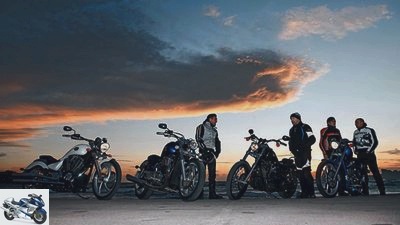
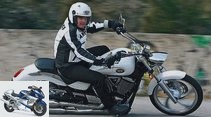
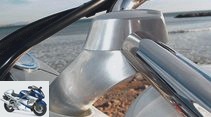
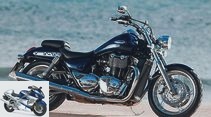
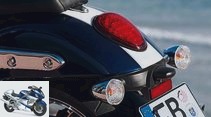
25th photos
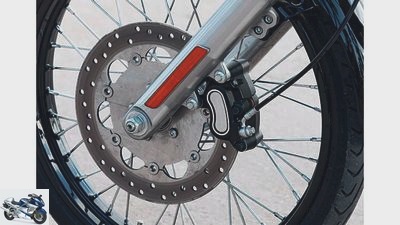
1/25
An ABS would not have done any damage to the braking system.

2/25
Custom look, no chrome-plated plastic, powerful engine and easy driving. The Victory is neatly processed, but the indicator lights do not look particularly valuable.
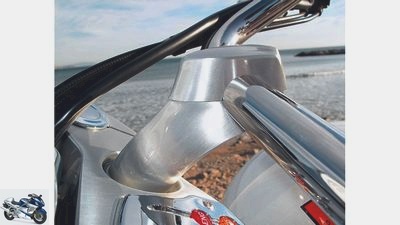
3/25
The parts of the Victory are not chrome-plated to the same extent as on Triumph, Harley and Honda, but their own look also has something of its own.
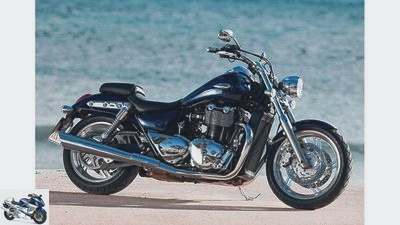
4/25
Triumph Thunderbild: Although the heaviest in the field, it remains the most stable in corners.

5/25
The Thunderbird can easily be seen from behind and also offers enough space for passengers.
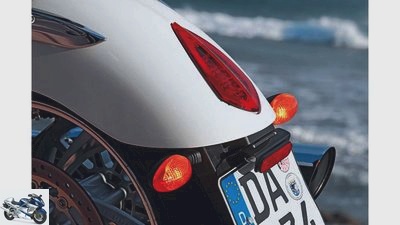
6/25
The space on the Victory remains quite limited for passengers.
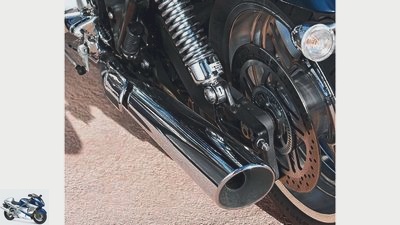
7/25
Unfortunately, the Triumph’s silencer doesn’t give that much for the ears.
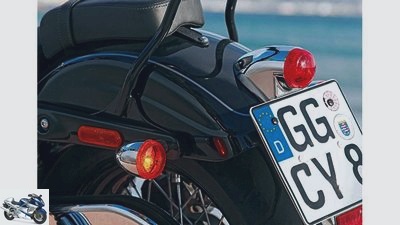
8/25
The passenger grab bar is also ideal for securely stowing luggage.
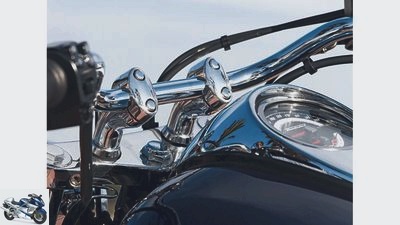
9/25
With the speedometer directly on the tank, the Triumph clearly stands out from the others.
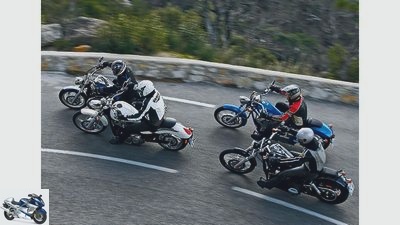
10/25
Get out of the mantra of "higher faster further". Here life is not a competition, but enjoying time. Cruise your life.
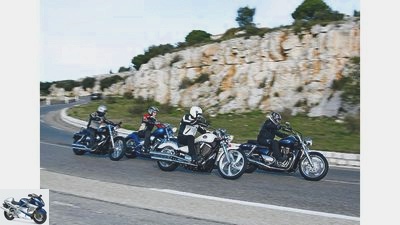
11/25
These bikes are just the thing for you to comfortably cruise over country roads.
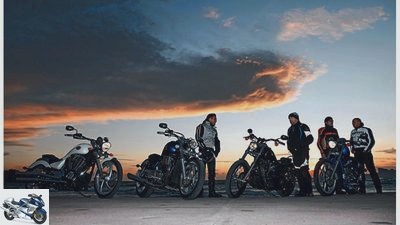
12/25
Got a bit of money left and don’t know what to do with it? How about cruising? Here you can get an overview of the four newest luxury cruisers.
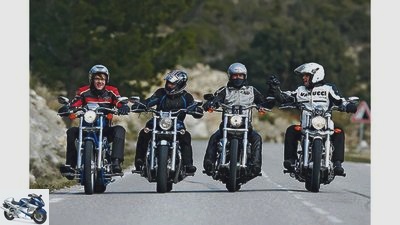
13/25
Overtaking unnecessary. It is much more fun to ride together in a group instead of against each other.
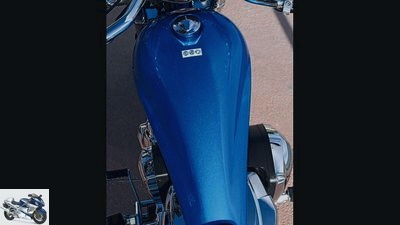
14/25
The beautifully slim styled tank unfortunately only holds a little gasoline. But the Honda’s low consumption can halfway compensate for the missing volume.
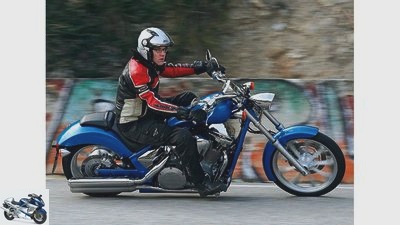
15/25
With its front wheel far in front, the Honda Fury is not for beginners.
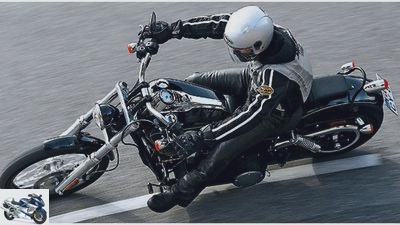
16/25
Timeless, stable in value, full of character – after the Wide Glide disappeared from the product range for a short time, it will be back in 2010. With a great sound, but only moderate braking.
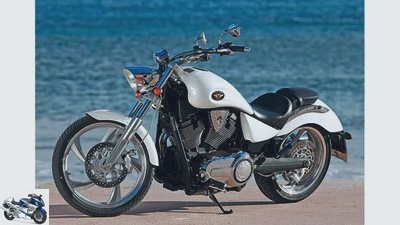
17/25
No engine has as much power as that of the Victory, above all, the Vegas runs as smoothly as hardly any other.
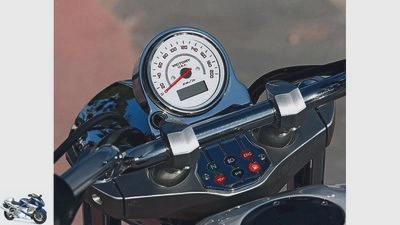
18/25
The only flaw is the poor workmanship of the indicator lights .
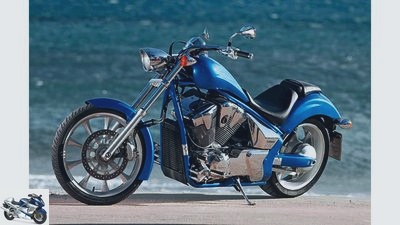
19/25
The Honda Fury offers a custom look in series: a beautifully styled chopper. Except for the brake line, everything looks very tidy. However, many parts are made of plastic that has been chrome plated.
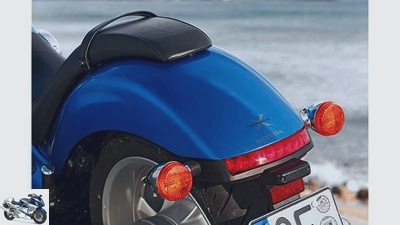
20/25
From the rear, the VT relies on a very unique design that clearly stands out from the competition.
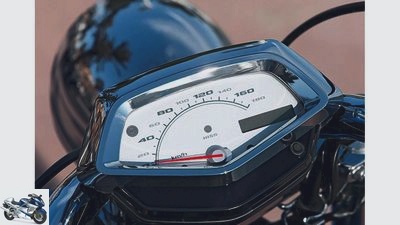
21/25
The clear, beautifully designed speedometer of the Honda.
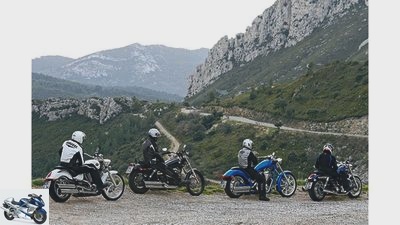
22/25
Four unique bikes that couldn’t be a better investment.
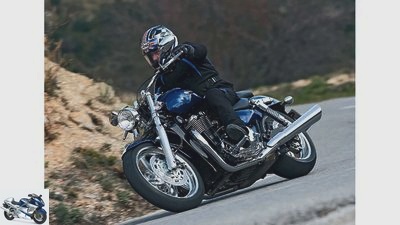
23/25
Independent, sporty, full of character and classic – and the heaviest bike in the test. Lots of chrome and also a heart for passengers.
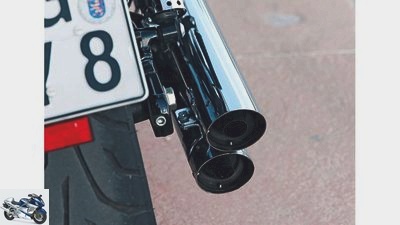
24/25
But the sound of the Harley is unique and unsurpassable.
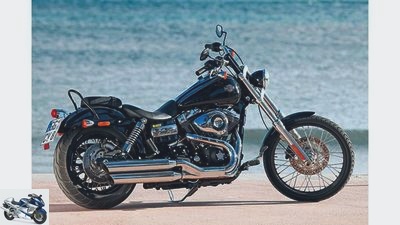
25/25
Next bike: Harley-Davidson Dyna Wide Glide.
Comparison test cruiser / chopper
Cruiser around 14,000 euros in comparison
Your children are out of the house, the ceiling falls on your head, and the building society contract that is finally due spits 14,500 euros into your account – what now? Have you ever thought seriously about cruising? Seldom has it been more refreshing than it is today.
The selection of characterful cruisers has never been as large as it is now: With the 1596 cubic Triumph Thunderbird, the British offer the largest parallel twin in the world. Harley-Davidson reissued its classic Dyna Wide Glide, the power cruisers from the US brand Victory have also been available in Germany since last fall, and Honda surprised everyone with the American-developed VT 1300 CX. A chopper for everyday use that is quite radical: 1805 millimeters wheelbase, 7.30 meters turning circle, tank in an extremely slim teardrop shape. These four fundamentally different bikes have one thing in common. They cost almost the same, namely around 14,500 euros. In the next chapters you will find out which machine offers what and how much for the money.
Buy complete article
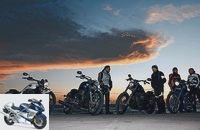
Comparison test cruiser / chopper
Cruiser around 14,000 euros in comparison
Thunderbird takes a completely different approach: The Britin is the tallest at 710 millimeters. And sits the most sporty: the footrests are not moved forward, the handlebars lie comfortably and loosely in the hand, the nerve cord between the hands and the front wheel is most direct here. Comfort is not neglected either, because the bench has something cozy. In contrast to the seat cushion of the Victory Vegas. The American motorcycle manufacturer can look back on eleven years of experience, but when it comes to seating comfort and saddle shape, the Americans should indulge: the sides rub against the edges of the thighs, and the back of the pillion cushion hits the spine. Otherwise it’s true. The handlebar is wonderfully cranked and lies actively in the hand, the footrests provide a good grip.
This is also true of the Honda, although you may not believe it when you see it in person for the first time. At 680 millimeters, the seat height of the chopper is just as low as that of the Vegas. But due to the elongated fork, the large space between the engine and the frame, the elongated tank and the huge wheelbase, the machine looks particularly long, to stick with the jargon. The waist of the VT is only a hand’s breadth, the engine pushes itself out of the frame like a foreign body. Nevertheless, surprisingly, you sit quite neatly. And above all cool: whoever takes a seat on the VT immediately feels like Peter Fonda.
The same feeling arises on the Wide Glide. Even a little stronger thanks to the forward footrests. In addition, the Glide is the only machine in the test field with which you can cover relatively relaxed distances on the motorway with a little trick, despite the forward stops: The small, metal pillion passenger handle mounted on the rear can be used as a support for a thick pack sack . It’s easy to lean against it when you’re traveling at 150 km / h on the autobahn. The competition cannot keep up with the series. Enough praise. Harley has mounted the passenger pegs directly on the swing arm, and the side stand is difficult to reach and can therefore hardly be unfolded when seated – real no-no’s. Also for freaks.
Sound and Power
Timeless, stable in value, full of character – after the Wide Glide disappeared from the product range for a short time, it will be back in 2010. With a great sound, but only moderate braking.
If sound grades were given, the Harley would get a two, the Honda a three and Victory and Triumph would get a five. Both the Wide Glide and the VT 1300 CX sound robust, bassy and self-confident. Expectations are met here. On the other hand, the old adage also applies to the dogs, which don’t bite when they bark. On the MOTORRAD test bench, the 1300cc Honda Vau only managed 54 hp at 4,300 tours, and of the 78 hp promised by the almost 1600 cc Harley V2, only 72 remained. Conversely, the quietest bikes turn out to be tough guys: the British twin sends 84 horses into the race at 5000 rpm, the powerful pistons of the 1731 cubic Victory-Vau develop 93 hp in their cylinders. But power is by no means everything.
Cruising has nothing to do with sportiness, but it should be said at this point: All four bikes have enough power to win traffic light sprints against almost all citizen cages and when riding on the autobahn stress-free in the disguise-free comfort zone between 120 and 140 km / h to slide. The embarrassing 39-hp difference between the almost equally heavy Victory Vegas and Honda VT can only be felt when overtaking. The scene: Last gear, 2,000 revs, 80 km / h, and suddenly this truck in front of you. While the Victory driver shoots his way past the obstacle with a loose twist of his wrist, the Honda driver has to shift down two gears for an adequate overtaking maneuver. Overtaking from the wrist is just as easy with the British twin, with the drive accelerating the most gently of all and revving up comparatively agile. Something that is completely alien to the Harley-V2. Its fat flywheel is always present – when you accelerate, you can’t get rid of the feeling of feeling engine components from the ship’s diesel. You have to love that. Or learn to love. Rapid overtaking from low engine speeds is difficult – if you pull up the gas in the sixth at 100 km / h, you will experience acceleration in slow motion. So switch down too.
Independent, sporty, full of character and classic – and the heaviest bike in the test. Lots of chrome and also a heart for passengers.
For many drivers, however, the individual character of the drive is more important than acceleration values. Seen in this way, top performance is not relevant at all. But what is the character? The mixture of firing order, crank pin offset, engine concept, bore-to-stroke ratio and centrifugal mass is largely responsible for how the drive feels to the driver. The Wide Glide drive, for example, has the highest solo entertainer value. It sniffs, shakes, vibrates, rocks, thumps, twitches and jerks. If you really give souls to some engines like a Chevy V8 or Lanz Bulldog – the TwinCam 96 engine from Harley Davidson is without a doubt one of them. Air-cooled, bumpers, camshaft below, no balance shaft, two valves. Something’s burning here. And explodes. The driver should kindly notice it. Combustion engine experience: right in the middle, instead of just being there.
Comparison test cruiser / chopper part 2
Get out of the mantra of "higher faster further". Here life is not a competition, but enjoying time. Cruise your life.
The Honda V2 is much more reserved in this regard, because it is more cultivated. Let’s say more Japanese. Two balancer shafts work against annoying vibrations, the pistons onions to and fro in water-cooled cylinders, and an overhead camshaft actuates three valves per tower. Despite the modern concept, the result is impressive. Perhaps because the engine is designed to be very long-stroke: You can tell the pistons travel their 104.3 millimeters every time you drive. Both connecting rods sit together on a crank pin. The 52-degree Vau stomps, toil and heaves with vigor and has its big moments in the first half of its speeds. Fascinating how the drive can cope with low-revving driving – smoother and more confident than the Harley-Vau.
Triumph Thunderbird. Also two balancer shafts, water-cooled, four-valve technology. The parallel twin opens a completely new way into the upscale cruiser world, which is dominated by the Vau engine concept. The twin presses 130 Newton meters to the rear wheel just above idle, and the maximum torque of 137 Nm is already available at 2600 tours. By far the heaviest machine in the comparison could practically only live with one gear. With the sixth namely. Honestly, the Twin feels uncomfortable in the upper third of the speed, turning does not help at all. The British have given the water-cooled twin towers an almost unbelievable smoothness. If it weren’t for the constantly very present machine weight and the beefy acceleration from low speeds – you might think that you have half the displacement under you, the twin runs so smoothly.
We come to the last alphabetical: Victory means victory. And indeed: The Americans have set up an air-cooled 50-degree V2 that virtually combines the advantages of the other engines. It runs smoother than the Harley-Vau, without depriving the driver of the combustion engine experience. However, it feels much more rocking than the Honda unit. And it already has almost as much thump as the Triumph-Twin from idle speed, but is far more revving. Hats off – he’s the new measure of all things. Unfortunately, the translation of Vegas is far too long. And the clutch is very difficult to operate.
Undercarriage – just let it run
Custom look in series: beautifully styled chopper. Except for the brake line, everything looks very tidy. However, many parts are made of plastic that has been chrome plated.
Anyone who expects comfort here will inevitably be disappointed. Minimum spring travel must compensate for maximum loads. Except for the Triumph, all chassis require a certain ability to suffer from the driver. Hard bumps are passed on to the tailbone and the spine just as quickly as messages to be more timid with regard to the incline. If there is a gusty wind from the right, the Harley exhaust, to put it exaggeratedly, is already on the straight. Honda and Victory hit the footrests first, but then the frame touches quickly – and you are levered off the track. Moved appropriately, the quartet works perfectly. If you still want to take it a little sportier from time to time, only the British will make you happy. The Thunderbird remains stable even in swift corners, while the Harley gauzes terrifyingly at the same speed, and you have the feeling that the front and rear wheels are no longer rolling on the same course.
Braking the brakes – ball ahead, child behind. More than six quintals must be slowed down to zero as quickly as possible. This is where the Honda sets top values with its semi-integral ABS. Theoretically, the deceleration values of the four candidates are not that far apart, as MOTORRAD determined during the brake test on a closed route. With an emergency stop from 100 km / h the Honda stopped after 40.48 meters (maximum deceleration 9.53 m / s2), the Triumph after 41.84 meters (9.22 m / s2), Harley’s Wide Glide stopped after 42.87 Meters (9.0 m / s2) and after 43.35 meters the Victory wheels came to a complete standstill (8.9 m / s2). It should be noted that these values were achieved by a very experienced test driver who was prepared for the emergency braking. Inexperienced users can decelerate at a similarly high level with both the Triumph and the Honda, because the machines are equipped with ABS. Which would also be urgently needed with the Harley and Victory, because with both brake systems the locking point of the tires is not in the least noticeable. Effective delay here requires the utmost attention and immense experience. Why only when there is an easier way?
The big easy
No engine has as much power as that of the Victory, above all, the Vegas runs as smoothly as hardly any other.
Let’s get to the core question: which machine for whom? If you don’t care about vibrations, braking and performance can be average, then you could be happy with the Harley chopper. The American original not only shines with chrome, but also with a high resale value and a strong image. In addition, the machine is the ticket to the largest motorcycle club in the world, the Harley-Owners-Group (HOG). In addition, the manufacturer has an accessories catalog ready, almost as thick as the Berlin telephone book. It couldn’t be more individual. However, if safety is your top priority, there is no way around the Honda chopper: foolproof operation, electronic immobilizer, best brakes, great ABS. Packed in a breathtaking look – the VT is an absolute eye-catcher. Albeit with a few catches: the 1300 requires an experienced pilot due to the extremely long distance between the saddle and the front wheel. Novice drivers should keep their hands off it. You shouldn’t care that many chrome-plated parts are made of plastic.
However, if you often want to be on the road with two people, have written power at the lowest possible revs and smoothness in your specifications, and are looking for unusual concepts, you should choose the Triumph Cruiser. In this quartet, it is the machine that enables the best mix of motorcycling and cruising. And: In addition to accessories suitable for touring, the British also offer a few custom parts. However, if you ultimately want performance paired with a real custom look, there is no way around the power custom cruiser Victory Vegas. The engine is a bench, the paintwork striking, and the machines are still rarities in Europe with a high cult potential. Four bikes with different characters and a philosophy of life, aside from any desire for competition – your 14,500 euros are better invested here than in the overnight money account.
Technical data Honda
The Honda VT 1300 CX.
Engine:
Water-cooled two-cylinder four-stroke 52-degree V-engine, two balance shafts, one overhead, chain-driven camshaft each, three valves per cylinder, rocker arm, dry sump lubrication, injection, Ø 38 mm, regulated catalytic converter, alternator 381 W, battery 12 V / 11 Ah, mechanically operated multi-plate oil bath clutch, five-speed gearbox, cardan, secondary gear ratio 2.66.
Bore x stroke 89.5 x 104.3 mm
Displacement 1312 cm3
Compression ratio 9.2: 1
rated capacity 42.5 kW (58 hp) at 4250 rpm
Max. Torque 107 Nm at 2250 rpm
Landing gear:
Double loop frame made of steel, telescopic fork, Ø 45 mm, two-arm swing arm made of aluminum, central spring strut, adjustable spring base and rebound damping, front disc brake, Ø 336 mm, three-piston floating caliper, rear disc brake, Ø 296 mm, two-piston fixed caliper.
Cast aluminum wheels 2.15 x 21; 5.25 x 18
Tires 90/90 R 21; 200 / 50-18
Dunlop Elite 3 tires tested
Mass and weight:
Wheelbase 1805 mm, steering head angle 58.0 degrees, caster 90 mm, spring travel f / r 130/95 mm, seat height * 680 mm, weight with a full tank * 311 kg, payload * 158 kg, tank capacity 12.8 liters.
guarantee two years
Service intervals 6000 km
Colours Blue, black
price 13990 euros
Price test motorcycle** 14590 euros
Additional costs around 170 euros
* Manufacturer information
** including ABS (600 euros)
Technical data Harley-Davidson
The Harley-Davidson Dyna Wide Glide.
engine:
Air-cooled two-cylinder four-stroke 45-degree V-engine, crankshaft horizontal, two chain-driven camshafts, two valves per cylinder, hydraulic valve lifters, bumpers, rocker arms, dry sump lubrication, injection, Ø 46 mm, uncontrolled catalytic converter, 493 W alternator, battery 12 V / 19 Ah, mechanically operated multi-disc oil bath clutch, six-speed gearbox, toothed belt, secondary ratio 2.063.
Bore x stroke 95.3 x 111.1 mm
Displacement 1585 cm3
Compression ratio 9.2: 1
rated capacity 57.0 kW (78 hp) at 5250 rpm
Max. Torque 126 Nm at 3500 rpm
landing gear:
Double loop frame made of steel, telescopic fork, Ø 49 mm, two-arm swing arm made of steel, two spring struts, adjustable spring base, front disc brake, Ø 300 mm, four-piston fixed caliper, rear disc brake, Ø 292 mm, double-piston floating caliper.
Spoked wheels with aluminum rims 2.15 x 21; 4.50 x 17
Tires 80 / 90-21; 180 / 60-17
Dunlop GT 502 tires tested
mass and weight:
Wheelbase 1715 mm, steering head angle 56.0 degrees, caster 132 mm, spring travel f / r 127/79 mm, seat height * 680 mm, weight with a full tank * 307 kg, payload * 185 kg, tank capacity / reserve 17.3 / 3.8 liters.
guarantee two years
Service intervals 8000 km
Colours Red Black
Performance variant 25 kW at 4750 rpm
price 14795 euros
Additional costs around 350 euros
* Manufacturer information
Technical data Triumph
The Triumph Thunderbird
Engine:
Water-cooled two-cylinder four-stroke in-line engine, two balance shafts, two overhead, chain-driven camshafts each, four valves per cylinder, injection, Ø 42 mm, regulated catalytic converter with secondary air system, 540 W alternator, 12 V / 18 Ah battery, mechanically operated Multi-disc oil bath clutch, six-speed gearbox, toothed belt, secondary ratio 2.214.
Bore x stroke 103.8 x 94.3 mm
Displacement 1596 cm3
Compression ratio 9.7: 1
rated capacity 63.0 kW (86 hp) at 4850 rpm
Max. Torque 146 Nm at 2750 rpm
Landing gear:
Double loop frame made of steel, telescopic fork, Ø 47 mm, two-arm swing arm made of steel, two spring struts, adjustable spring base, double disc brake at the front, Ø 310 mm, four-piston fixed calipers, disc brake at the rear, Ø 310 mm, double-piston floating caliper.
Cast aluminum wheels 3.50 x 19; 6.00 x 17
Tires 120/70 R 19; 200/50 R 17
Tires in the Metzeler ME 880 test
Mass and weight:
Wheelbase 1641 mm, steering head angle 58.0 degrees, caster 151 mm, spring travel f / r 120/95 mm, seat height * 710 mm, weight with a full tank * 338 kg, payload * 232 kg, tank capacity 22.0 liters.
guarantee two years
Service intervals 10000 km
Colours Black, blue / white, silver / black
price 13740 euros
Price test motorcycle** 14340 euros
Additional costs around 250 euros
* Manufacturer information
** including ABS (600 euros)
Technical data Victory
The Victory Vegas
Engine:
Air-cooled two-cylinder four-stroke 50-degree V engine, a balance shaft, one overhead, chain-driven camshaft, four valves per cylinder, rocker arm, wet sump lubrication, injection, Ø 45 mm, regulated catalytic converter, 450 W alternator, 12 V / 18 battery Ah, mechanically operated multi-disc oil bath clutch, six-speed gearbox, toothed belt, secondary ratio 2.121.
Bore x stroke 101.0 x 108.0 mm
Displacement 1731 cm3
Compression ratio 9.4: 1
rated capacity 66.0 kW (90 PS) at 4900 rpm
Max. Torque 140 Nm at 3250 rpm
Landing gear:
Double loop frame made of steel, telescopic fork, Ø 43 mm, two-arm swing arm made of aluminum, central spring strut with lever system, adjustable spring base, front disc brake, Ø 300 mm, four-piston fixed calipers, rear disc brake, Ø 300 mm, double-piston floating caliper.
Cast aluminum wheels 2.15 x 21; 5.5 x 18
Tires 90/90 R 21; 180/55 R 18
Dunlop Elite 3 tires tested
Mass and weight:
Wheelbase 1684 mm, steering head angle 57.1 degrees, caster 140 mm, spring travel f / h 130/76 mm, seat height * 680 mm, weight with a full tank * 306 kg, payload * 226 kg, tank capacity 17.0 liters.
Guarantee two years
Mobility guarantee two years
Service intervals 8000 km
Colours Blue White Red
price 14490 euros
Additional costs around 250 euros
* Manufacturer information
MOTORCYCLE measurements
Drawing: archive
Power on the crankshaft. Measurements on Dynojet chassis dynamometer 150, corrected according to 95/1 / EG, maximum possible deviation +/- 5%.
Vegas is where the hammer hangs you could say. Because the American air-cooled V2 sets the bar very high. Even if he accelerates a bit rougher than the competition and doesn’t run as smoothly as the Triumph. The Thunderbird twin can handle the highest speeds, but this virtue is little in demand when cruising. Overall, the coordination of all four engines was successful – without any loss of power or torque.
Top speed:
| Manufacturer information | km / h |
| Harley-Davidson | 195 | Honda | 165 |
| triumph | 185 | Victory | 193 |
Acceleration:
| Manufacturer information | 0-100 km / h |
0-140 km / h |
| Harly-Davidson | 5.4 | 10.9 | Honda | 6.8 | 14.5 |
| triumph | 4.8 | 9.4 | Victory | 4.2 | 8.0 |
Draft:
| Manufacturer information | 60-100 km / h |
100-140 km / h |
140-180 km / h (in sec) |
| Harly-Davidson | 5.9 | 6.9 | 16.2 | Honda | 6.6 | 8.8 | – |
| triumph | 4.8 | 6.5 | 11.5 | Victory | 4.2 | 5.2 | 8.2 |
Fuel consumption (country road):
| Manufacturer information | Liters / 100 km |
| Harley-Davidson | 5.1 | Honda | 4.6 |
| triumph | 4.9 | Victory | 5.3 |
Theoretical range (country road):
| Manufacturer information | kilometre |
| Harley-Davidson | 339 | Honda | 278 |
| triumph | 449 | Victory | 321 |
Conclusion
These bikes are just the thing for you to comfortably cruise over country roads.
1st place: Triumph Thunderbird
Stable chassis, powerful engine, ABS, suitable for pillion, no real weaknesses – the British woman convinces across the board.
2nd place: Honda VT 1300 CX
Sound and optics are right, the brakes are great, and the engine raptures despite its poor performance with good vibrations – what more could you want? Well, maybe 20 hp…
3rd place: Victory Vegas
Great engine in a good chassis combined with a sensational look. With ABS or less toxic rear brakes, the Vegas would be further ahead.
4th place: Harley-Davidson Wide Glide
Iconic, classic, timeless – but the comparatively sluggish engine, the sluggish chassis and bad brakes prevent a better placement.
Scoring:
Category engine:
The liter output of the big ships is very modest for all of them. The rear of the line is the Honda V2, which only shines with its good gearbox and smooth running. The Harley-Vau does this with very little load change reactions, but in return it annoys with the worst smoothness. No wonder: Victory uses one balance shaft, Triumph and Honda even two. An absolute no-go is the extremely stiff clutch operation on the Victory, it goes smoothly as fitness training for super men. Other shortcomings of the Vegas V2: The gearbox cannot be shifted very well and it is far too long at 210 km / h in fifth and 250 km / h in sixth gear. An electronic throttle stops the propulsion at exactly 193 km / h.
Winner engine: triumph
Category chassis:
You shouldn’t expect miracles, they are not handy. The steering behavior of the VT is clouded by its extreme chassis geometry and the wide 200 mm rear tires. The Triumph struggles with its extra weight and the Harley’s completely inactive seating position prevents more direct steering. Nevertheless, the Wide Glide is relatively handy. The Triumph comes up with the best chassis. It responds cleanly, is comparatively comfortable, enables the greatest possible inclination freedom, offers the best feedback and even in pillion mode it still has reserves. In need of improvement: The Victory fork and the Harley shock absorbers tend to be too soft, while the Honda fork does its job anything but sensitive and hops over bumps.
Chassis winner: triumph
Category everyday life:
It has to be cool, but cool is usually anything but ergonomic. From an occupational therapy point of view, the Harley is a disaster for the driver. But it looks casual. And if passengers are charged and loaded on each of these bikes, they should get an adequate seat cushion in advance in the accessories shop and bring them with them. In terms of workmanship, the Honda has to take a big hit: a lot of chrome-plated plastic, and the rear silencer is not even made of stainless steel, but rather charmingly hidden behind a chrome panel. Second imposition: The VT may load a maximum of 158 kilograms – petite, agile, agile passengers wanted.
Winner everyday: triumph
Category Security:
A highlight: The Honda stoppers are not only stable and easy to dose, they are also equipped with a very sensitive ABS and are most effective. Neither Harley nor Victory offer an ABS, which is urgently needed. Because the rear brake of the Vegas is extremely difficult to adjust, and the front stoppers of the Harley require much too much manual force. With both machines, you can hardly guess where the blocking point is.
Safety winner: Honda
Category costs:
Lowest consumption, but too small a tank: the Honda has to be the first to go to the gas pump. Victory and Triumph charge a higher insurance premium due to their performance and rub off their tire tread more quickly.
Winner cost: Honda
| Max. score |
Harley-Davidson | Honda | triumph | Victory | |
| Overall rating | 1000 | 419 | 439 | 515 | 438 | placement | 4th. | 2. | 1. | 3. |
| Price-performance note | Top grade 1.0 | 4.0 | 4.0 | 4.0 | 4.0 |
Price-performance winner: Triumph
The grade 4.0 is the worst that MOTORRAD awards for the price-performance ratio. Nevertheless, the Triumph should be highlighted because it scores significantly more points than the competition.
Related articles
-
Comparison test: Honda VFR 800 against VFR 1200 F
fact 25 pictures fact 1/25 old against new: Honda VFR 800 (in the foreground) against the new VFR 1200 F. fact 2/25 Honda VFR 1200 F (right) against the …
-
Comparison test: three-quarter liter chopper
Bilski comparison test: three-quarter liter choppers Two small choppers in comparison Machines that sparkle in the sun, with which you can …
-
fact comparison test Super Tourer, BMW K 1200 GT, Honda Pan European, Kawasaki 1400 GTR, Yamaha FJR 1300 Four travel professionals When the wanderlust calls and …
-
Comparison test of the 500 all-rounder
Jahn Comparison test of the 500 all-rounder Class reunion The three 500s from Honda, Kawasaki and Suzuki have enjoyed various training programs and also…
-
Comparison test: large naked bikes
fact comparison test: Large naked bikes, BMW K 1300 R, Honda CB 1300 S, Suzuki B-King, Yamaha XJR 1300 Large naked bikes in comparison Contents of a …
-
Comparison test of the sports tourers from BMW and Honda
fact 12 pictures fact 1/12 Top brakes: radially screwed six-piston stoppers, ABS and integral actuation. fact 2/12 Builds compact and very narrow: the …
-
Gargolov comparative test Nurburgring To hell and back Nurburgring, Nordschleife. 94 curves, 46 crests, four super athletes and a greenhorn. A…
-
Jahn Enduro comparison test, BMW F 650 GS Dakar, KTM 640 LC 4, MZ Baghira Enduro, Yamaha XT 660 R Waldgeister meet at lightning speed on winding …
-
Comparison test KTM 990 Supermoto versus Ducati Hypermotard 1100
Mayer comparison test KTM 990 Supermoto versus Ducati Hypermotard 1100 Supermoto duel Crass edges or curved lines: With the Hypermotard 1100 …
-
Gargolov Comparison test big bikes: Honda CBR 1100 XX Super Blackbird, Kawasaki Ninja ZX-12R, Suzuki GSX 1300 R Hayabusa, Yamaha FJR 1300 A Two fast, two…